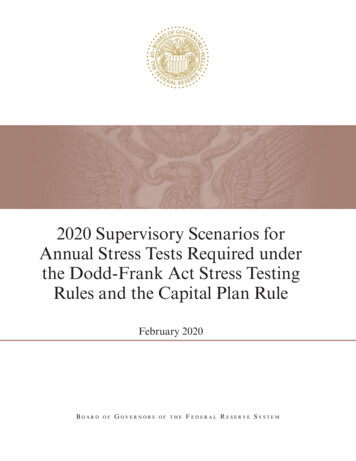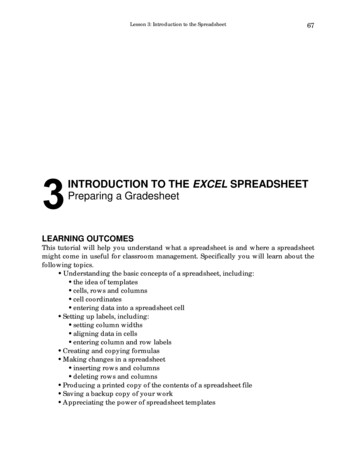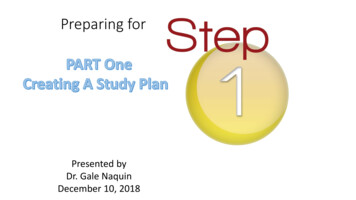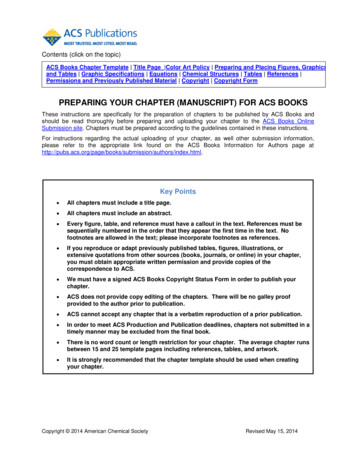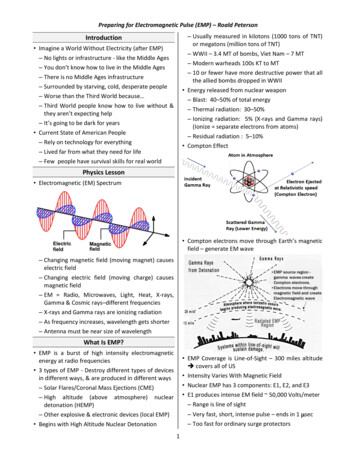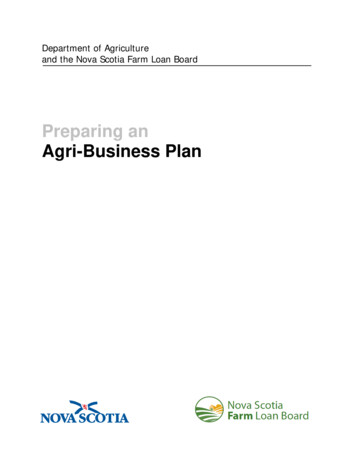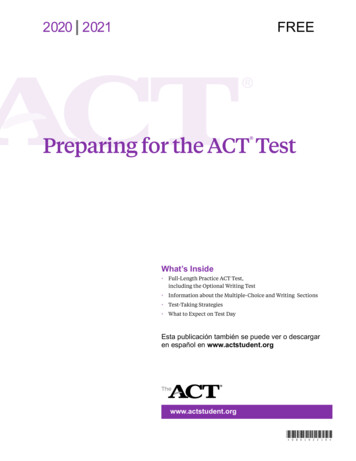
Transcription
2020 l 2021 FREEPreparing for the ACT Test What’s Inside Full-Length Practice ACT Test,including the Optional Writing Test Information about the Multiple-Choice and Writing Sections Test-Taking Strategies What to Expect on Test DayEsta publicación también se puede ver o descargaren español en www.actstudent.orgwww.actstudent.org*080192210*
A Messageto StudentsContents2A Message to StudentsOverview of the ACTTest-Taking Strategies34This booklet is an important first step as you get ready forProhibited Behavior at theTest Center 6college and your career.Content of the ACT Tests7Taking the Practice Tests11The information here is intended to help you do your beston the ACT to gain admission to colleges and universities.Practice Multiple-Choice SectionsPractice Writing Test12as a complete practice ACT, with “retired” questions from53How to Score the Multiple-ChoiceTests 56Reviewing Your Performance on theMultiple-Choice Tests 56How to Score the Writing TestSample Answer DocumentIncluded are helpful hints and test-taking strategies, as well6163earlier tests given on previous test dates at ACT test sites.Also featured are a practice writing test, a sample answerdocument, answer keys, and self-scoring instructions.Read this booklet carefully and take the practice tests wellbefore test day. That way, you will be familiar with the tests,what they measure, and strategies you can use to do yourbest on test day.You may also want to consider the The Official ACT SelfPaced Course, Powered by Kaplan to learn test contentand strategies in a virtual classroom. To view all of our testpreparation options, go to www.act.org/the-act/testprep.ACT is committed to representing the diversity of society in all its aspects, including race, ethnicity, and gender. Questions, passages, and writing prompts are chosen toreflect a range of cultures and are written to not disadvantage any particular group of examinees. ACT employs extensive reviews and statistical procedures to ensure thefairness of test materials.ACT conducts research and periodically updates tests to provide test content that reflects classroom instruction and continues to be a relevant predictor of college andcareer readiness. There may be subtle differences between the ACT practice test in this booklet and the test students take on test day.ACT endorses the Code of Fair Testing Practices in Education and the Code of Professional Responsibilities in Educational Measurement, which guide the conduct ofthose involved in educational testing. ACT is committed to ensuring that each of its testing programs upholds the guidelines in each Code. You may locate copies of theseCodes through the following organizations: Code of Fair Testing Practices in Education: American Psychological Association (www.apa.org) Code of Professional Responsibilities in Educational Measurement: National Council on Measurement in Education (www.ncme.org)NOTE: This booklet is covered by federal copyright laws that prohibit the reproduction of the test questions without the prior express, written permission ofACT, Inc. No portion of this booklet may be copied or distributed without written permission of ACT. 2020 by ACT, Inc. All rights reserved. JA00003.CJ31502
Overview of the ACTTest Strategies for the ACTThe full ACT consists of four multiple-choice sections—inEnglish, mathematics, reading, and science—with an optionalwriting section. Some colleges and universities require oraccept ACT writing scores, so you may consider taking thewriting section.TestQuestionsMinutes per 351 essay40Writing (optional)Each multiple-choice section contains questions with eitherfour or five answers from which you are to choose the correct, orbest, answer.The ACT measures the knowledge, understanding, and skillsyou have acquired throughout your years in school. Because ofthis, it is unlikely that a “cram” course can improve your scores.However, it is a good idea to do some test preparation to befamiliar with the tests and what to expect on test day.Here are three strategies to help you prepare for the ACT:9 Get familiar with the content of the sections.Test Formats for ACTNational TestingReview the information in this booklet. Note which contentareas make up a large proportion of the sections. The topicsincluded in each content area are examples of possible topics;they do not include all possibilities.The full ACT is now offered nationally in both paper and onlineformats. Students who have taken the full ACT at least once in2016 or later will be able to retake individual sections duringany of the National test dates through ACT Section Retesting.A section retest is an online only test option that offers a way tohelp you focus on individual ACT sections. Students can take upto 3 sections during one testing date and can choose in whichorder the sections are taken. See www.actstudent.org for moreinformation about ACT Section Retesting.9 Update your knowledge and skills in the contentareas.Review content areas that you have studied but are not fresh inyour mind. Refresh your knowledge in the content areas thatmake up large portions of the test.9 Study content areas you are not familiar with.If some content areas of the ACT are unfamiliar to you, considertaking coursework in those areas before you take the test.ACT tries out questions on National test dates to developfuture tests. Your test may include questions that will notcount towards your score. These questions may be blendedin with the questions that do not count towards your score orwill be presented in a 5th test that will not be reflected on yourreported scores. Please try your best on these questions. Yourparticipation can help shape ACT’s future.With blended questions, your time will be extended to allow forthe additional questions.TestQuestionsMinutes per 451 essay40Writing (optional)3
Test-Taking Strategies9 Answer every question.These suggestions apply to the four multiple-choice sections.Your scores in the sections will be based only on the numberof questions that you answer correctly; there is no penalty forguessing. Try to answer every question within the time allowedfor each section.9 Pace yourself.It is important that you have enough time to read the passages/questions and figure out your responses. For each section,subtract the number of minutes you estimate you will spendskimming the passages or reading the information provided,then divide the total number of remaining minutes allowed bythe number of questions to determine the estimated time youshould spend on each question. If possible, spend less time oneach question and use the remaining time allowed for a sectionto review your work and return to the questions in that sectionthat were most difficult for you.9 Review your work.If there is time left after you have answered every question in asection, go back and check your work. You will not be allowed togo back to any other section or mark responses to a section aftertime has been called in that section.9 Be precise in choosing your responses.If you are taking the ACT on paper, be sure that you properly fillin the appropriate ovals on your answer document. Check thatThe time limits set for each section give nearly everyoneenough time to finish all questions. However, you will want topace yourself to avoid spending too much time on one passageor puzzling over an answer to a specific problem. Go on to otherquestions and come back if there is time.the number of the line of ovals on your answer document is thesame as the number of the question you are answering and thatyou mark only one answer for each question. If you are takingthe ACT online, be sure you select the intended response.9 Read the directions carefully.9 Erase completely.Before you begin each section, read the directions carefully. If you want to change a multiple-choice answer on paper, besure to use a soft eraser that will erase the unintended markcompletely and not leave smudges. Do not cross out answersor use correction fluid or tape; you must erase. Smudges orunintended marks may cause errors in scoring.The English, reading, and science sections ask for the bestanswer. Read and consider all of the answer choices andchoose the answer that best responds to the question.The mathematics section asks for the correct answer. Youmay want to work out the answer you feel is correct and lookfor it among the choices given. If your answer is not amongthe choices provided, reread the question and consider allthe answer choices.Get ReadyPrepare well in advance for the ACT. 9 Read each question carefully.You need to understand exactly what each question asks. Somequestions will require you to go through several steps to findthe correct or best answer, while others can be answered morequickly. 9 Answer the easy questions first.A good strategy is to answer the easy questions and skip thequestions you find difficult. After answering the easy questions,go back and answer the more difficult questions if you havetime. 9 Use logic on more difficult questions.When you return to the more difficult questions, try to use logicto eliminate incorrect answers. Compare the answer choicesto each other and note how they differ. Such differences mayprovide clues as to what the question requires. Eliminate asmany incorrect answers as you can, then make an educatedguess from the remaining answers.Know what to expect on test day. Review the information inthis booklet and at www.actstudent.org.Take the practice tests in the order they are shown in thisbooklet, time yourself, and review your responses using theanswer keys.If you are taking individual sections through ACT SectionRetesting, you can use the practice tests in this booklet formore preparation.You can practice using the online testing format used forsection retesting, or for taking the full ACT online by visitingpractice.actdigitalservices.org.Carefully review the test-day checklist atwww.act.org/the-act/checklist.Get plenty of rest the night before the tests.Note: Most procedures in this booklet refer to testing on aNational test date at an ACT test site (within the United States,US territories, or Puerto Rico). Procedures may differ slightly ifyou take a different administration of the ACT test.4
On Test Day Report on Time For National test dates, you must report to your assignedtest site by the time stated on your admission ticket (usually8:00 a.m.). If you are late, you will not be admitted to test. Ifyour ticket does not list a specific test room, the test staff orposted signs will direct you. Testing with one and one-half time is available on the multiplechoice and/or writing sections for students with diagnoseddisabilities and/or limited English proficiency. This is availablefor the full ACT and Section Retesting.At check-in, you will be required to show an acceptable photoID or you will not be admitted to test. See ACT requirementsfor ID on your ticket or at www.act.org/the-act/id.Your admission ticket is also required if you test on aNational ACT test date. You will not be admitted to the testwithout it. It contains identifying information for bothtesting on paper and online formats. If you have lost yourticket, you can print another through your ACT web account.If you are approved for one and one-half time at a National testsite, you will have 50% additional time to complete each section.The full ACT:TestIf testing in the United States, bring sharpened No. 2 pencilsand good erasers (no mechanical pencils or ink pens). Ifyou are testing internationally, you will be provided writingimplements. Do not bring any other writing instruments.You will not be allowed to use them.A watch to pace yourself. Do not bring a watch withrecording, internet, communication, or calculatorcapabilities (e.g., a smart watch or fitness band). You will beasked to remove your watch and place it face up on your deskduring testing. QuestionsMinutes per 551 essay60QuestionsMinutes per TestWriting (optional)Section Retesting:TestA permitted calculator may be used on the mathematicssection only. It is your responsibility to know whetheryour calculator is permitted. For the most currentinformation on the ACT calculator policy, visitwww.act.org/calculator-policy.html or call 800.498.6481 for arecorded 1 essay60ScienceWriting (optional)In the Test Room If you take the ACT Section Retests, dismissal time forsection retesting will depend on which and how manysections you choose to take.For Students Approved to Testat National Test SitesWith One and One-Half TimeBring With You For the full ACT, you will normally be dismissed at about12:35 p.m. if you take the ACT (no writing), or at about 1:35p.m. if you take the ACT with writing.After TestingTest staff will direct you to a seat. If you need a left-handeddesk, tell the staff as you enter.Voiding Your Test on Test DayDo not leave the test room after you have been admitted.If you have to leave the test site before completing all of yourtests, you must decide whether or not you want your test scoredand then inform the test staff of your decision. If you do not,your test will be scored.Only pencils, erasers, a permitted calculator, your watch(if brought to the test center), and your paper ticket will beallowed on your desk.You will be required to put all other personal belongingsaway.Once you access test content, you cannot request a Test DateChange. If you do not complete all your sections and want totest again, you will have to pay the full fee for your test optionagain. Once you begin filling out your test, you cannot changefrom one test option to another.You may not use tobacco in any form. You may consumesnacks and drinks outside the test room during break.Reporting time for the test will be 8:00 a.m. Testing willbegin as soo
best, answer. The ACT measures the knowledge, understanding, and skills you have acquired throughout your years in school. Because of this, it is unlikely that a “cram” course can improve your scores. However, it is a good idea to do some test preparation to be familiar with the tests and what to expect on test day. Here are three strategies to help you prepare for the ACT: 9 Get familiar .
